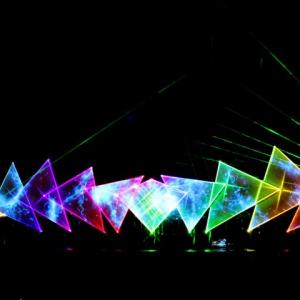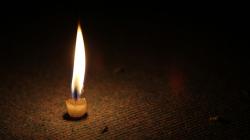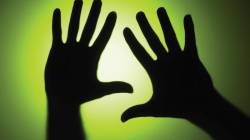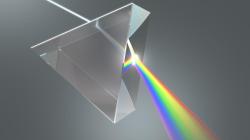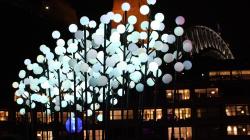'LIGHT IMITATES ART' IS ONE OF OUR NEW TEACHING SEQUENCES FOR AC V9
- On the 'Sequence overview' tab you'll find all the lessons in this sequence and curriculum alignment.
- The 'Our design decisions' tab shows how key scientific ideas develop over the sequence, and shows how the sequence addresses curriculum achievement standards.
- The 'Preparing for this sequence' tab guides you through important information and considerations for this sequence.
- Have you taught this sequence? Use the Feedback button to let us know how it went!
Launch
Lesson 1 • Do you see what I see?
This lesson introduces the sequence content—exploring light, how it is transferred, and what happens when its path is interrupted by different objects—and context—how light can be used for artistic, decorative, and celebratory purposes.
Inquire
Lesson 2 • How does light help us see?
Students identify sources of light and investigate how light is transferred and helps us to see.
Lesson 3 • Can we change the direction light is travelling?
Students consolidate the idea that light travels in straight lines, and that the direction of light is changed when it hits a reflective surface.
Lesson 4 • What happens to light when it hits a non-reflective surface?
Students investigate to find out how light interacts with translucent, transparent and opaque materials.
Lesson 5 • How can I make a shadow shorter or taller?
Students consolidate the idea that the direction, angle and proximity of a light source to an object will affect the shadow that is formed.
Lesson 6 • Does light travel through water?
Students investigate to find out what happens when light travels through a substance other than air, in this case, water.
Lesson 7 • What colour is light?
Students investigate the primary colours of light and what happens when these colours are combined.
Act
Lesson 8 • Designing a light artwork
Students apply their understanding of light, reflection, the creation of shadows, refractions and the colour spectrum of light, to design (and potentially make) a sculpture or artwork utilising one or more of these aspects.
The Australian Academy of Science supports and encourages broad use of its material. Unless indicated below, copyright material available on this website is licensed under a Creative Commons Attribution-NonCommercial-ShareAlike 4.0 International (CC BY-NC-SA 4.0) licence.
Curriculum and syllabus alignment
Achievement standards
By the end of Year 5 students identify sources of light and model the transfer of light to explain observed phenomena. They describe examples of collaboration leading to advances in science, and scientific knowledge that has changed over time. They identify examples where scientific knowledge informs the actions of individuals and communities.
Students plan safe investigations to identify patterns and relationships and make reasoned predictions. They identify risks associated with investigations and key intercultural considerations when planning field work. They identify variables to be changed and measured. They use equipment to generate data with appropriate precision. They construct representations to organise data and information and describe patterns, trends and relationships. They compare their methods and findings to those of others, identify possible sources of error in their investigation, pose questions for further investigation and draw reasoned conclusions. They use language features that reflect their purpose and audience when communicating their ideas and findings.
Australian Curriculum V9 alignment
Science as a human endeavour
Science understanding
Identify sources of light, recognise that light travels in a straight path and describe how shadows are formed and light can be reflected and refracted
Science inquiry
Pose investigable questions to identify patterns and test relationships and make reasoned predictions
Plan and conduct repeatable investigations to answer questions, including, as appropriate, deciding the variables to be changed, measured and controlled in fair tests; describing potential risks; planning for the safe use of equipment and materials; and identifying required permissions to conduct investigations on Country/Place
Compare methods and findings with those of others, recognise possible sources of error, pose questions for further investigation and select evidence to draw reasoned conclusions
Write and create texts to communicate ideas and findings for specific purposes and audiences, including selection of language features, using digital tools as appropriate
Australian curriculum content links
| Science understanding core concept: Energy can be transferred and transformed from one form to another and is conserved within systems |
| Sub-strand | Content descriptor | AC code | Achievement Standard | How the sequence addressed this content |
| SHE: Nature and development of science | Examine why advances in science are often the result of collaboration or build on the work of others. | AC9S5H01 | Describe examples of collaboration leading to advances in science, and scientific knowledge that has changed over time. | Explore how and why scientists create standards instruments and scales of measurement, specifically the use of light meters. (Lesson 4) |
| SHE: Use and influence of science | Investigate how scientific knowledge is used by individuals and communities to identify problems, consider responses and make decisions. | AC9S5H02 | Identify examples where scientific knowledge informs the actions of individuals and communities. | Examine how reflection is used to convey information to motorists in emergency situations. (Lesson 4) Consider how people use and manipulate light for their own purposes. (Lessons 1-8) |
| SU: Physical sciences | Identify sources of light, recognise that light travels in a straight path and describe how shadows are formed and light can be reflected and refracted | AC9S5U03 | They identify sources of light and model the transfer of light to explain observed phenomena. | Identify and categorise sources of light. (Lessons 1, 2) Identify that light travels in straight lines. (Lesson 2, 3) Determine how the path of light can be changed when it hits a reflective surface. (Lesson 3) Explore how shadows are formed when light hits opaque surfaces (Lesson 4), and how the size and shape of shadows can be manipulated. (Lessons 4, 5) Explores how light can be refracted. (Lesson 6) |
| SI: Questioning and predicting | Pose investigable questions to identify patterns and test relationships and make reasoned predictions. | AC9S5I01 | Plan safe investigations to identify patterns and relationships and make reasoned predictions. | Poses investigable questions relating to light. (Lessons 2-7) Makes predictions about what might happen when light hits reflective (Lesson 3), opaque (Lessons 4, 5), transparent and translucent (Lesson 3) materials. |
| SI: Planning and conducting | Plan and conduct repeatable investigations to answer questions, including, as appropriate, deciding the variables to be changed, measured and controlled in fair tests; describing potential risks; planning for the safe use of equipment and materials; and identifying required permissions to conduct investigations on Country/Place. | AC9S5I02 | Identify risks associated with investigations and key intercultural considerations when planning field work. They identify variables to be changed and measured. | Plan and conduct a fair test investigation to determine variables that can affect the height of a shadow. (Lesson 5) |
| SI: Planning and Conducting | Use equipment to observe, measure and record data with reasonable precision, using digital tools as appropriate. | AC9S5I03 | Use equipment to generate data with appropriate precision. | Uses appropriate measurement tools to measure the length/height of shadows accurately. (Lesson 5) |
| SI: Processing, modelling and analysing | Construct and use appropriate representations, including tables, graphs and visual or physical models, to organise and process data and information and describe patterns, trends and relationships. | AC9S5I04 | Construct representations to organise data and information and describe patterns, trends and relationships. | Construct ray diagrams to show the path of light (Lessons 2, 3), what happens when shadows are formed (Lessons 4, 5), what happens when light is refracted (Lesson 6). Construct data tables and graphs to record and analyse data regarding shadow height. (Lesson 5) |
| SI: Evaluating | Compare methods and findings with those of others, recognise possible sources of error, pose questions for further investigation and select evidence to draw reasoned conclusions. | AC9S5I05 | Compare their methods and findings to those of others, identify possible sources of error in their investigation, pose questions for further investigation and draw reasoned conclusions. | Uses finding from previous tests to inform choices for subsequent testing of materials. (Lessons 3, 4) |
| SI: Communicating | Write and create texts to communicate ideas and findings for specific purposes and audiences, including selection of language features, using digital tools as appropriate. | AC9S5I06 | Use language features that reflect their purpose and audience when communicating their ideas and findings. | Create a labelled plan of a light sculpture/artwork, explaining how the light is used to create desired effects. (Lesson 8) |
Science journals
Create a class science journal, either in hard-copy or digitally. You might:
- use/create a large scrap book or flip chart.
- use poster/butchers’ paper so learning can be displayed in sequence on the wall.
- create a digital journal using your platform/ technology of choice.
- any combination of the above.
Plan for students’ creation of an individual science journal, either in hard-copy or digitally. They might:
- use an exercise book, scrap book or flip chart to record their thinking and gather resource sheets together.
- use a folder to store and collate resource sheets, diagrams, photographs etc.
- use a digital folder to store work samples, images and videos.
- any combination of the above.
See Using a science journal throughout inquiry for more detailed information on the importance of science journals.
Additional preparation
- Read through the teaching sequence.
- Note any adaptations you would like to make to suit your school’s and students’ context.
- Determine if your students will only design or will design and make a sculpture/artwork at the end of the sequence.
- Consider if you would like them to work as individuals, in teams, or if you will work as a whole class collective to design the sculpture/artwork.
- Consider how/where you will display the sculptures/artworks, and who you will invite to see them and hear about they were created.
- Begin collecting the resources required to teach the sequence.
The materials required for each lesson are listed on the lesson's page. For the full sequence resource list, download the Preparing to teach this sequence document below.
